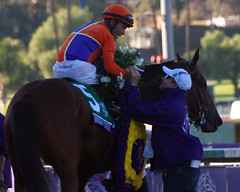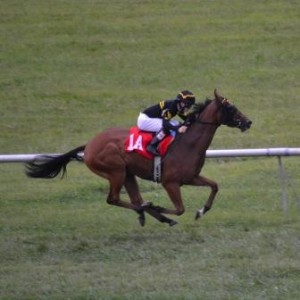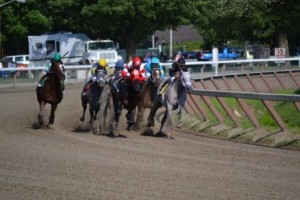Mar 20
2015

Beholder and Gary Stevens. Photo by Alicia Hamm
Continuing on the theme of a prior article on “Visual Handicapping” we’re going to get into more details on questions raised there. Click here to review the visual handicapping article, and learn more about the differences between visual handicapping and trip handicapping.
With visual handicapping, it’s always important to look beyond the raw numbers (i.e. Beyer Speed Figures, Pace Figures, Running Lines) in the Daily Racing Form and ask the question, “How did they do it?”
We raised some of these questions before, but we’ll ask them again:
Read More >>
Oct 29
2014

In a prior article we introduced TimeformUS and a list of our favorite features. Click here to read that article.
Included in our list of favorite features was “expanded trip notes.” In addition to these, TimeformUS offers additional “Perspective Comments” that are available for the majority of races that were run in Europe. These comments are extensive and quite often provide more than just trip related information. For example, sometimes there are comments that reflect the quality of the competition in the race and/or prior races. At other times, there are comments about where the horse is headed next, whether or not the horse is suited to try different distances, go up in class, etc. With the influx of European horses for the Breeders’ Cup, this type of information can provide the horseplayer with an edge over players who do not have access to these comments.
Read More >>
Oct 23
2014

We classified this article under the “Trips” category, but in fairness it involves much more than the “good” or “bad” trip approach to handicapping. Trip handicappers are always on the lookout for circumstances where a horse ran worse than expected, but had one or more excuses that explain their sub-par performance. This can offer value when other bettors jump off that horse’s bandwagon.
On the flip side, discovering that an above average performance was bolstered by a favorable trip can offer value on other horses in an upcoming race. For example, maybe a horse benefited from a speed duel, and was sitting in the “garden spot” immediately behind dueling leaders who tired dramatically in the stretch. If circumstances in his next race are different, he might not fare so well.
Read More >>
Nov 13
2013

Trip handicapping is the art of watching video race replays and making notes when a horse was aided or harmed by extraordinary racing conditions. This is especially valuable when your observations are not fully reflected in the race comments captured in the program or racing form. Keep in mind that the majority of horseplayers are limited to these comments, so to know something other players do not know is to have an advantage over them.
With that said, the interpretation of good and bad trips is highly subjective. Don’t let your observation be tainted by prejudices, such as focusing only on a horse you wagered on. Also, try to determine if the problems a horse encountered really made a difference in the outcome. If a horse was blocked by another – was it just as he was about to make a move? Or, was it in the latter stages after he had already shown signs of weakening.
Read More >>
Aug 5
2013
Post position refers to the position of each horse in the starting gate, starting from the inside rail and working out. This is usually, though not always the same number as the wagering number for each horse. The times when it differs is when you have a “coupled” entry in a race. A coupled entry is when two or more horses are running for the same common ownership.

Looking at the picture to the left, and working from the inside out, you can see that the #2 horse is in post one, #3 in post two, #4 in post three, etc. Following #7 is the #1A horse in post seven. #8 must have been scratched, so #9 follows #1A in post eight. Since there is no #1 horse, we know that he must have been scratched too.
Post positions in and of themselves are not important. Post positions relative to where the starting gate is located on the track, the running style (e.g. early speed vs. closer) for each horse, and the size of the field are quite important.
Read More >>
Jul 10
2013
In a prior post we briefly introduced trip notes in conjunction with a review of full trip descriptions in result charts. Click here to see that post. In this post we’re going to focus on the terminology used in the abbreviated trip notes shown in the Past Performances (PPs) of each horse. These trip notes are part of what is referred to as the comment line in the PPs.
The comment line is a subset of the full description found in the result chart for a specific horse. Since it is confined to one line and relatively few characters, it can be rather cryptic to read. DRF describes the contents of the comment line as follows:
A capsule description of the horse’s performance written by the chart caller. Emphasis is placed on trouble encountered during the race and/or how it finished. If the horse won the race, the manner in which it won is indicated – driving, ridden out, handily or easily (in order of effort).
Here we will provide some examples and further description of some comment terminology used in the comments. Read More >>
Jun 20
2013
Result charts are a complete account of what happened in a race. As opposed to the Past Performances (PPs) for an individual horse, which reflect a subset of the result chart information; and is focused only on information specific to that horse. Before the Internet, result charts were accessible only by clipping them out of the Daily Racing Form and saving them in your own well guarded file. A collection of well organized result charts was considered gold by many handicappers. However, today they are available with the click of a mouse. Read More >>





